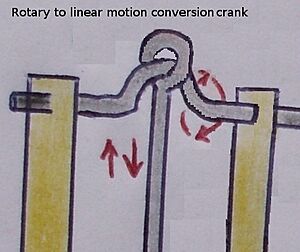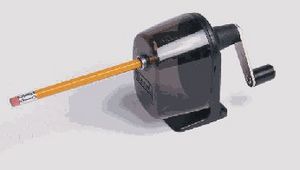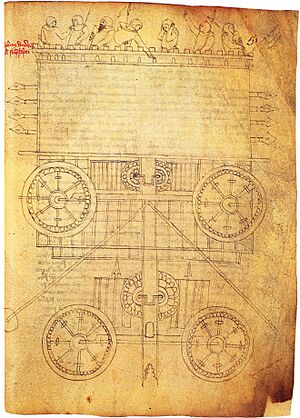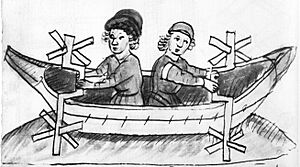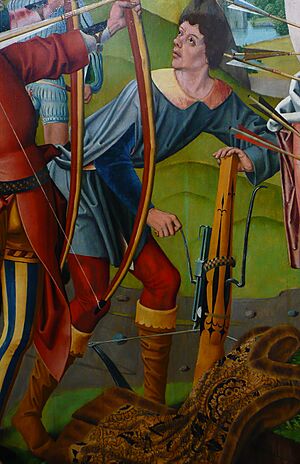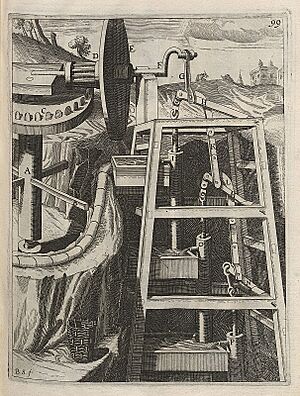Crank (mechanism) facts for kids
A crank is a special arm that helps turn a spinning rod or shaft. It's attached to the shaft at a right angle. Imagine turning a handle to make something spin – that handle is often a crank!
When a crank works with a connecting rod, it can change circular motion into a back-and-forth motion. It can also do the opposite. The crank arm can be a bent part of the shaft itself. Or, it can be a separate arm or disk attached to the shaft. A rod, usually called a connecting rod, is attached to the end of the crank with a pivot.
Often, a crank is powered by a person. It helps you manually turn an axle. Think of a bicycle crankset or a drill used by hand. In these cases, your arm or leg acts like the connecting rod. It pushes and pulls the crank. There's usually a bar at the end of the crank arm. This bar often has a handle or pedal that can spin freely.
Contents
What are some examples of cranks?
You can find cranks in many everyday things:
Cranks powered by hand
- Spinning wheels use cranks to spin thread.
- Many mechanical pencil sharpeners have a hand crank.
- Fishing reels use cranks to wind in fishing lines.
- Older cars sometimes needed a starting handle (a crank) to get them going.
- Manually operated car windows use cranks to roll them up or down.
- A carpenter's brace is a type of crank.
- Handcycles use cranks that you push with your hands.
- Hand winches use cranks to pull heavy things.
Cranks powered by feet
- The crankset on a bicycle is powered by your feet on the pedals.
- Old Treadle sewing machines used foot pedals to power a crank.
Cranks in engines
Almost all reciprocating engines use cranks. They work with connecting rods. This system changes the back-and-forth movement of pistons into spinning motion. These cranks are part of a larger piece called a crankshaft.
How old are cranks?
Cranks in China
Historians once thought the first true crank handle was found in China. It was on a model of a farm tool from around 200 AD. But since then, older models have been found. Some date back to the Western Han dynasty (202 BC - 9 AD). These models show cranks used for winnowing fans.
The Chinese also used cranks with connecting rods very early on. They used them for grinding grain in querns during the Western Han dynasty. Later, cranks and connecting rods were used for many other tasks. These included sifting flour, spinning silk, and powering furnace bellows.
Cranks in the Western World
Ancient Times
The handle for a rotary handmill appeared in Spain around 5th century BC. It later reached Greece. A Roman iron crankshaft from the 2nd century AD was found in Switzerland. It was about 82.5 cm (32.5 inches) long.
Another Roman crank-operated mill was found near Munich. It dates to the late 2nd century AD. This shows cranks were used for grinding grain.
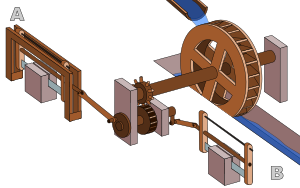
The first clear proof of a crank combined with a connecting rod in a machine is from the Roman Hierapolis sawmill. This was in Asia Minor (modern-day Turkey) in the 3rd century AD. Two other Roman stone sawmills from the 6th century AD also used this system. These sawmills used waterwheels to power saws. The saws cut large stone blocks using connecting rods and cranks. This means the crank and connecting rod system was invented much earlier than once thought.
Middle Ages
A spinning grindstone with a crank handle is shown in a drawing from around 830 AD. This is one of the earliest pictures of a crank. Musical instruments and even pictures of Fortuna (the goddess of luck) turning her wheel of destiny show cranks.
A monk named Theophilus Presbyter (c. 1070−1125) wrote about crank handles. He said they were used for turning casting cores.
An Italian doctor, Guido da Vigevano (c. 1280−1349), drew plans for a paddle boat. He also drew war carriages. These were moved by hand-turned cranks and gear wheels. A book from around 1340 shows a grindstone turned by two cranks.
Cranes in the Middle Ages sometimes used cranks to lift things.
Renaissance
Crank use became common in Europe by the early 1400s. The German engineer Konrad Kyeser showed cranks in his designs. These included cranks for crossbows, water-lifting machines, and even bell wheels. He also added cranks to Archimedes screws for lifting water. This made them much easier to use.
The carpenter's brace with a compound crank appeared around 1420-1430. An unknown German engineer wrote about military technology. He showed how connecting rods were used with cranks. He also showed how flywheels helped cranks move smoothly past their "dead spots."
One drawing from this time shows a boat with paddle-wheels. Men turned these wheels using cranks. This idea was improved by Italian engineers like Roberto Valturio and Francesco di Giorgio.
In Italy, early drawings of cranks and connecting rods appeared in sketchbooks. Later, artists like Pisanello showed a clear understanding of how cranks worked. He painted a pump driven by a water-wheel using cranks and connecting rods.
The 1400s also saw cranks used on crossbows. These cranked devices helped load the crossbows with more force. In the textile industry, cranks were used to wind yarn.
By the 16th century, many books showed cranks and connecting rods in machine designs. For example, Agostino Ramelli's book from 1588 showed 18 examples. Another book by Georg Andreas Böckler from 1661 showed 45 different machines using cranks.
Cranks in the Middle East
The crank appeared in the mid-9th century in the Middle East. The Banū Mūsā brothers described them in their book, Book of Ingenious Devices. These devices used cranks for partial rotations.
Al-Jazari (1136–1206) described a crank and connecting rod system. He used it in two of his water-raising machines. His pump had a crankshaft.
Cranks in the 20th century
Cranks were very common on machines in the early 1900s. For example, most phonographs before the 1930s were wound with cranks. Reciprocating piston engines still use cranks. They change the straight motion of pistons into spinning motion.
Early 20th-century cars often had to be started with hand cranks. These were called "starting handles" in the UK. Later, electric starters became common. One of the last cars to use a hand crank was the Citroën 2CV, made from 1948 to 1990.
The 1918 Reo car manual explained how to start the car with a hand crank. You had to make sure the car was in neutral and the brakes were on. You also had to set the spark and carburetor controls. Then, you would grasp the crank handle and pull it upwards quickly. It was important never to push down. This was because if the motor kicked back, it could hurt the person starting it.
What is a crank axle?
A crank axle is a special type of crankshaft. It also works as an axle. These are used in steam locomotives that have inside cylinders.
See also
- Beam engine
- Crankshaft
- Human power
- James Pickard
- Piston motion equations
- Slider and crank mechanism
- Slider-crank linkage
- Sun and planet gear
- Trammel of Archimedes
- Winch



